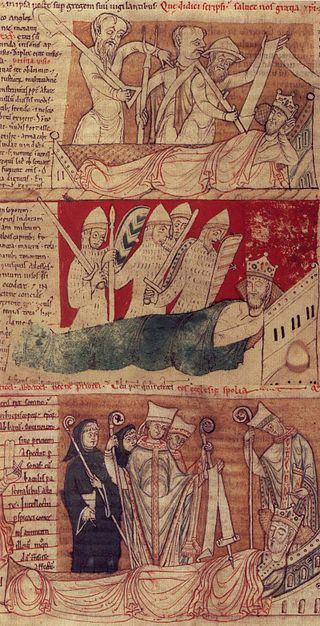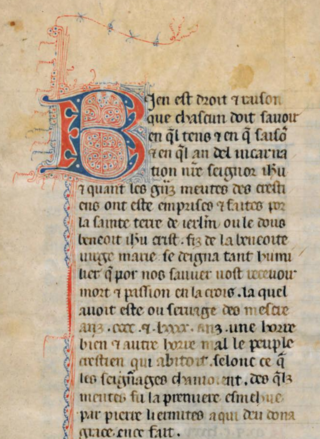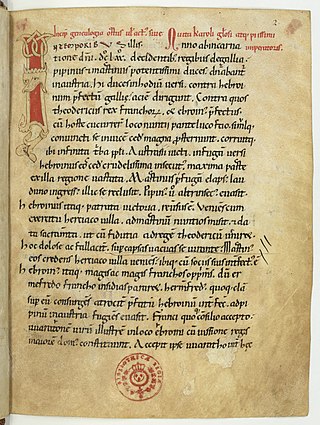Related Research Articles

A chronicle is a historical account of events arranged in chronological order, as in a timeline. Typically, equal weight is given for historically important events and local events, the purpose being the recording of events that occurred, seen from the perspective of the chronicler. A chronicle which traces world history is a universal chronicle. This is in contrast to a narrative or history, in which an author chooses events to interpret and analyze and excludes those the author does not consider important or relevant.

The Chronicle of Moissac is an anonymous compilation that was discovered in the abbey of Moissac, but is now thought to have been compiled in the Catalan monastery of Ripoll in the end of the tenth century. Like most chronicles, it begins with Adam, but gains increasing interest for historians as it nears its end date of 828. Unfortunately, a folio with the entries covering the years 716–770 is missing. The only surviving manuscript of the Chronicle of Moissac dates from the later 11th century and is now in the French National Library in Paris.

The Royal Frankish Annals, also called the Annales Laurissenses maiores, are a series of annals composed in Latin in the Carolingian Francia, recording year-by-year the state of the monarchy from 741 to 829. Their authorship is unknown, though Wilhelm von Giesebrecht suggested that Arno of Salzburg was the author of an early section surviving in the copy at Lorsch Abbey. The Annals are believed to have been composed in successive sections by different authors, and then compiled.

The Codex Beneventanus is an 8th-century illuminated codex containing a Gospel Book. According to a subscription on folio 239 verso, the manuscript was written by a monk named Lupus for one Ato, who was probably Ato, abbot (736–760) of the monastery of San Vincenzo al Volturno, near Benevento. The unusual odd number of Canon Tables suggests these seven folios were prepared as much as two centuries earlier than the rest of the codex.

The Gesta principum Polonorum is the oldest known medieval chronicle documenting the history of Poland from the legendary times until 1113. Written in Latin by an anonymous author, it was most likely completed between 1112 and 1118, and its extant text is present in three manuscripts with two distinct traditions. Its anonymous author is traditionally called Gallus, a foreigner and outcast from an unknown country, who travelled to the Kingdom of Poland via Hungary. Gesta was commissioned by Poland's then ruler, Boleslaus III Wrymouth; Gallus expected a prize for his work, which he most likely received and of which he lived the rest of his life.

John of Worcester was an English monk and chronicler who worked at Worcester Priory. He is now usually held to be the author of the Chronicon ex Chronicis.
A tonary is a liturgical book in the Western Christian Church which lists by incipit various items of Gregorian chant according to the Gregorian mode (tonus) of their melodies within the eight-mode system. Tonaries often include Office antiphons, the mode of which determines the recitation formula for the accompanying text, but a tonary may also or instead list responsories or Mass chants not associated with formulaic recitation. Although some tonaries are stand-alone works, they were frequently used as an appendix to other liturgical books such as antiphonaries, graduals, tropers, and prosers, and are often included in collections of musical treatises.

San Vincenzo al Volturno is a historic Benedictine monastery located in the territories of the Comunes of Castel San Vincenzo and Rocchetta a Volturno, in the Province of Isernia, near the source of the river Volturno in Italy. The current monastery, housing a group of eight Benedictine nuns, is located to the east of the river, while the archaeological monastery of the early Middle Ages was located on the west.

The Annales laureshamenses, also called Annals of Lorsch (AL), are a set of Reichsannalen that cover the years from 703 to 803, with a brief prologue. The annals begin where the "Chronica minora" of the Anglo-Saxon historian Bede leaves off—in the fifth year of the Emperor Tiberios III—and may have originally been composed as a continuation of Bede. The annals for the years up to 785 were written at the Abbey of Lorsch, but are dependent on earlier sources. Those for the years from 785 onward form an independent source and provide especially important coverage of the imperial coronation of Charlemagne in 800. The Annales laureshamenses have been translated into English.

The Anglo-Saxon Chronicle is a collection of annals in Old English, chronicling the history of the Anglo-Saxons.
Tigernach Ua Braín was abbot of Clonmacnoise and abbot of Roscommon. He was once held to be the author of the Annals of Tigernach, hence its name; this view is no longer sustainable, though the nature and extent of his involvement remain unclear.
The Chronicon Aquitanicum is a set of annals covering the years 830 to 930 with several gaps and an added notice on the year 1025. It is found in the "great encyclopedia codex", BN lat. 5239, of the Abbey of Saint Martial at Limoges. Its entries are annotations on an Easter cycle.

The Annals of Vendôme are a set of medieval annals covering events from 678 to 1347. They survive in a single manuscript copy, the exemplar of which came from the Abbey of the Holy Trinity at Vendôme.
The Historia Francorum Senonensis is a short anonymous Latin chronicle of the Frankish kings from 688 down to 1015. It was written at Sens before 1034 and is hostile towards the Capetian dynasty that had taken the throne of West Francia in 987. It was a popular and widely used text, and its anti-Capetian view is largely responsible for the questions raised by many later authors concerning the dynasty's legitimacy.

The Libellus de expugnatione Terrae Sanctae per Saladinum, also called the Chronicon Terrae Sanctae, is a short anonymous Latin account of the conquests of Saladin in the Holy Land between 1186 and 1191. The core of the text was written shortly after the events it describes and then supplemented by the addition of an account of the Third Crusade early in the thirteenth century. This probably took place at Coggeshall Abbey in England. Neither the original author nor the continuator/compiler is known by name.

The Annales de Terre Sainte is a series of brief annals of the Crusades and the Crusader states from the council of Clermont in 1095 until the fall of Acre in 1291. It is untitled in the manuscripts. Its modern title was coined by its 19th-century editors. The original is in Old French, but an Old Spanish translation is also known. For the thirteenth-century Crusades, it is a valuable and independent historical source.
Peter I was the bishop of Benevento from 887 or 894 until at least 902. His pontificate was marked by rapid political shifts, with Benevento successively under Byzantine (891–895), Spoletan (895–897) and Lombard rule. Peter was imprisoned and exiled a first time in 895. He served as the regent and de facto ruler of the Principality of Benevento between 897 and 900. In 902, he was proclaimed prince by the people but refused the office and went into exile a second time. He died in 914, possibly still in exile. He was buried in Benevento

The Chronicon universale usque ad annum 741 is an anonymous Latin chronicle from the creation of the world to AD 741. It was written in Francia, probably in Burgundy, between 741 and 775. It survives wholly or partially in at least six manuscripts.

The Chronicle of Aniane is an anonymous Latin history covering the rise of the Carolingian family from 670 to 840. It was composed by a monk of the Abbey of Aniane (Hérault).
Rerum italicarum scriptores ab anno æræ christianæ quingentesimo ad millesimumquingentesimum is a collection of texts which are sources for Italian history from the 6th to the 15th century, compiled in the 18th century by Ludovico Antonio Muratori.